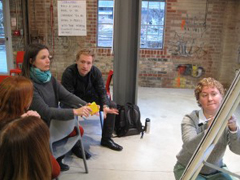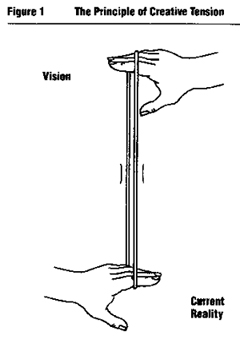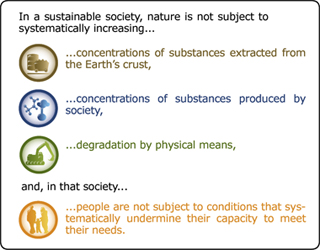Sustainability-driven Collaboration, Part II: Value Creation and Vision as a Driving Force
 The article Sustainability-driven Collaboration, Part II: Value Creation and Vision as a Driving Force written by Chad Park, Executive Director of The Natural Step Canada, is the second blog as part of a series that was originally published on the Social Innovation Generation website.
The article Sustainability-driven Collaboration, Part II: Value Creation and Vision as a Driving Force written by Chad Park, Executive Director of The Natural Step Canada, is the second blog as part of a series that was originally published on the Social Innovation Generation website.
***
In the first post of this three-part series, Sustainability-driven Collaboration, I discussed the imperative for profound systems change to address sustainability challenges, which provoked the question: how we can provide a platform for sustainability-driven collaboration in which participants are able to embrace complexity and reframe ‘wicked problems’ as ‘wicked opportunities’?
At the level of individual organizations, there is a long history of studying the distinction between efforts leading to incremental change versus transformational change, in particular sustainability-driven change. Research and experience in this area have led to methodologies like the Framework for Strategic Sustainable Development, by which organizations can credibly aim for sustainability-driven transformational change.
Although multi-stakeholder collaboration differs from such methodologies in many ways and presents a host of unique challenges, it seems likely that at least some lessons from sustainability-driven organization-level change can apply, or be adapted to apply to the context of multi-stakeholder collaborative change efforts. Approaches that have been successful at the organization level may similarly improve the capacity of collaborative efforts to achieve transformational systems change towards sustainability.
 1. Focus on value creation – For organization-level change initiatives to achieve transformational results, it is crucial that sustainability be seen as a driver of business value as opposed to a cost centre. Nowhere is the case for sustainability as a driver of business value better made than in the work of Bob Willard, whose “Seven Business Case Benefits of a Triple Bottom Line” continue to be used to build boardroom buy-in on sustainability initiatives around the world. At an organizational level, the seven benefits are as follows: Easier hiring of top talent, higher retention of top talent, higher productivity from employees, reduced expenses in manufacturing, reduced expenses at commercial sites, increased revenue, and reduced risk and easier financing.
1. Focus on value creation – For organization-level change initiatives to achieve transformational results, it is crucial that sustainability be seen as a driver of business value as opposed to a cost centre. Nowhere is the case for sustainability as a driver of business value better made than in the work of Bob Willard, whose “Seven Business Case Benefits of a Triple Bottom Line” continue to be used to build boardroom buy-in on sustainability initiatives around the world. At an organizational level, the seven benefits are as follows: Easier hiring of top talent, higher retention of top talent, higher productivity from employees, reduced expenses in manufacturing, reduced expenses at commercial sites, increased revenue, and reduced risk and easier financing.
While a focus on value creation is no less important in a collaborative context, the added complexity that stems from the need to align the various interests and value-drivers of diverse stakeholders can make finding mutual benefit a much more complicated task than at the organization level. A multi-stakeholder collaborative effort must be capable of achieving compelling value creation at both the collective and organization/individual levels. This is the key insight and opportunity in Michael Porter and Mark Kramer’s popular Shared Value concept. Collective value acts as a centripetal force, lending cohesion to collaborative efforts, while value to the organization/individual dictates whether each party is willing to stay involved in a messy process with the sort of “emergent outcomes” typical of collaborative efforts.
Change Lab and Transformative Scenario Planning pioneer Adam Kahane, speaking at the 2013 Accelerate: Collaborating for Sustainability conference, summed up the importance of value creation, saying that: “The key to people choosing to stay at the table is understanding that they cannot get where they want to go otherwise.”
2. Use vision as the driving force – In order to move beyond incremental changes that still feel like costs to the kinds of breakthroughs where real value lies, organizations must be clear about what sustainability requires and therefore get ambitious about goal-setting. If one thing has been learned through work at the organization level, it is that vision-driven change efforts consistently lead to more profoundly transformational results, which tend to accrue the most value.
 Peter Senge uses the metaphor of an elastic band being stretched between two hands – one representing current reality and the other representing the desired future. This metaphor describes the innovation and motivation that can be generated through creative tension. This tension is most powerful and most useful to drive innovation and change when:
Peter Senge uses the metaphor of an elastic band being stretched between two hands – one representing current reality and the other representing the desired future. This metaphor describes the innovation and motivation that can be generated through creative tension. This tension is most powerful and most useful to drive innovation and change when:
a) The vision remains ambitious;
b) The accounting of current reality is rigorous and honest; and
c) The gap between the two can be clearly and simply expressed as key transitions (i.e. we need to move from a system with X characteristics to a system with Y characteristics).
The power of vision as a driver of change in organizations seeking breakthrough outcomes has been demonstrated again and again by businesses such as Interface, Nike, and The Co-operators.
The need for a shared sense of success will be no less important for participants engaged in collaborative efforts. That said, it may not be advisable to rush towards a detailed shared vision in a multi-stakeholder context. In collaborations involving diverse stakeholder groups with widely different interests, the pressure to get agreement on a unifying vision risks generating something very high-level and abstract. As the director of the Sustainable Food Lab, Hal Hamilton, said at a Breakthrough Capitalism event in Toronto in November 2013: “We don’t believe in a common vision. Oxfam and Walmart will never share the same vision.” Getting to a shared vision that is detailed enough to actually provide direction risks consuming a great deal of precious time and threatens participation levels, particularly among groups where there is a strong orientation to immediate action.
Although a single, detailed vision may not be possible or helpful when dealing with systems as complex as those targeted by collaborative systems change initiatives, it is difficult to be strategic in the determination of key priorities, or to maintain energy and momentum, without the tension provided by some shared understanding of success. However, success need not only be defined as a vision statement; it can also be articulated using principles.
Fortunately, scientists and thought leaders have done some helpful heavy lifting for us in this regard. Natural and social science can tell us the system conditions for sustainability, beyond which ecological systems will be eroded and social well-being will deteriorate below minimum levels, leading to divisiveness, instability, or breakdown. These system conditions address the root causes of our unsustainable path and use them to describe a principle-based articulation of a future sustainable state.
With reference to the elastic band metaphor, these science-based system conditions can serve as tacks on either end of the band, helping maintain the creative tension. They help ensure that the visions we create remain descriptive of a sustainable future state; in our analysis of the current system, they help us make sure we are rigorous so we don’t “lie to ourselves” about the current situation.
 While they do not describe a specific sustainable future, the system conditions provide the boundary conditions within which society and systems can operate indefinitely and within which any sustainable future must exist. As such, system conditions serve as design constraints and can act as a compass for ongoing, adaptive change efforts. This is an approach referred to by The Natural Step as backcasting from principles. It has been used by hundreds of leading organizations in the sustainable business and sustainable community fields.
While they do not describe a specific sustainable future, the system conditions provide the boundary conditions within which society and systems can operate indefinitely and within which any sustainable future must exist. As such, system conditions serve as design constraints and can act as a compass for ongoing, adaptive change efforts. This is an approach referred to by The Natural Step as backcasting from principles. It has been used by hundreds of leading organizations in the sustainable business and sustainable community fields.
In the context of multi-stakeholder collaborations, backcasting from system conditions for sustainability can help address the dilemma presented by the need for compelling, ambitious goals versus the difficulty of developing meaningful shared visions amongst diverse stakeholders. For example, we can collectively agree that we need to design a transportation system that doesn’t contribute to climate change and then each actor at the table can find ways to describe their organization’s role within that broader context – the organization’s vision will be specific, while success for the broader collaborative effort will be expressed on a principle level, but with no less ambition.
In the third and final entry of this three-part series, I will discuss three more lessons learned from organization-level change efforts that can be adapted for multi-stakeholder collaboration: simplicity without reduction, authentic leadership, and the importance of process design.
Source: www.sigeneration.ca
Want to engage further in the conversation about sustainability-driven collaboration? The Natural Step Canada is excited to host the 2nd annual Accelerate: Collaborating for Sustainability Conference on June 5-6, 2014, in Toronto. Join us to deepen learning about collaboration from experts and practitioners, experience collaboration by creating connections with other change agents, and seed new collaborative initiatives. Learn more and register today!
- Log in to post comments

